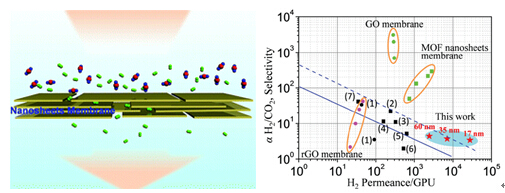Membrane-based gas separation plays an important role in various industrial processes. Traditional membranes are subject to a trade-off between permeance and selectivity known as Robeson’s upper-bound. To overcome this limitation, ultrathin membranes made of single-atom-thick nanosheets have been recently fabricated, which opens a new era for high-performance gas separation. Presently, the development of nanosheets-based ultrathin membranes (graphene oxide and metal-organic framework) suggest that ultrathin membranes constructed by stacking nanosheets in a proper manner have great potential for achieving excellent gas separation performance beyond expectation.
Prof. JIN Jian’s Lab, at Suzhou Institute of Nano-tech and Nano-bionics, Chinese Academy of Sciences, reported for the first time the use of single-layered molybdenum disulfide (MoS2) nanosheets as building blocks for constructing laminate-stacked ultrathin membranes for high-permeance H2 separation. The work was recently released in Nanoscale 2015, 7, 17649-17652.
As a typical layered material, MoS2 processes good chemical and thermal stability and is mechanically strong. In addition, the current preparation technique for single-layered MoS2 nanosheets in massive weight via chemical exfoliation is becoming more and more mature. These membranes exhibit extremely high gas permeance up to several thousand GPUs. Among them, the H2 permeance approaching 28000 GPUs with H2/CO2 selectivity larger than 3 is achieved by 17-nm-thick MoS2 membrane, surpassing the 2008 Robeson upper bound of polymeric membranes and the 2010 upper bound of microporous inorganic membranes. Featuring easy preparation, high H2 permeance, and high thermal stability, our ultrathin single-layered MoS2 membranes exhibit great potential for H2/CO2 separation application.
This work was supported by the projects from This work was supported by the Key Project of National Natural Science Foundation, the National Natural Science Foundation of China, the Key Development Project of Chinese Academy of Sciences, the Natural Science Foundation of Jiangsu Province, and the Youth Innovation Promotion Association, CAS.

Figure 1. Comparison of MoS2 membranes with polymeric membranes and inorganic microporous membranes for H2/CO2 separation.(Image by JIN Jian's group)
Contact information:Prof.JIN Jian
Suzhou Institute of Nano Tech and Nano Bionics ,Chinese Academy of Science
Suzhou,Jiangsu 215123,China.
E-mail:jjin2009@sinano.ac.cn

